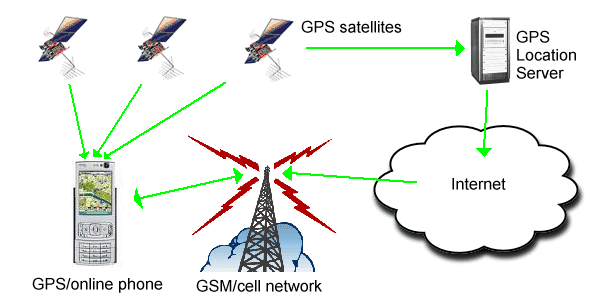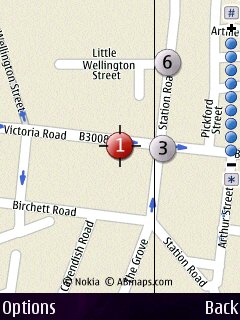In the last few months, we've had three Symbian smartphones equipped with on-board GPS (the N95, the E90 and the 6110 Navigator), while a similar number have shipped in the Windows Mobile world. It's true that few of these GPS receivers have been at anywhere near the performance level of standalone accessories, but the trend is fairly clear and the convenience benefits of integral GPS can't be denied. Give it another year and I think we'll be seeing almost every 'smartphone' include GPS.
To get to this point, of course, lock-on times (Time To First Fix, or TTFF) and sensitivity have to be improved, but the technology will get there, of that I'm sure. With virtually every mobile device now being able to count on an Internet connection, whether through GPRS or 3G, the extra few kilobytes needed to grab up to date GPS almanac data (where the satellites are in the sky) from a server are neither here nor there. Note that such an 'Assisted-GPS' system can either be run generically or using a specific network operator-run centre, with the latter presumably able to include known cell location data as well, in order to speed things up further.

Assisted GPS, as demonstrated this week on the Nokia N95, speeds up the TTFF significantly in two ways. The received GPS signals are shifted in frequency due to the relative receiver-satellite motion (Doppler shift). The GPS receiver must find the frequency of the signal before it can lock on. Knowledge of each satellite's position and velocity from an Assisted GPS server effectively reduces the number of frequencies to be searched because there's less guesswork involved, speeding TTFF up by (potentially) tens of seconds.
Even more significantly, normally a receiver has to spend at least 20 seconds (and often a lot more) decoding the navigation data from the satellites it can find, before it can start the triangulation calculations to work out a position on the Earth's surface. With Assisted GPS, the navigation data is provided, more or less perfectly (think of it as a crib that the GPS can use).
Add the two factors together and it's easy to see that even in worst case, TTFF can be reduced by 30 seconds or so. A final benefit comes from increased receiver sensitivity, which is directly related to the number of frequencies which must be searched to find a satellite signal. Because the GPS receiver has fewer frequencies to search, it can dwell on each for a greater period of time, increasing the effective sensitivity and enabling the GPS to use signal strengths below the normal thresholds to make range measurements (for example in built-up areas where many satellites are blocked by obstructions).
At the moment, management of GPS positioning in smartphones is semi-automatic but there's often still a little fiddling to be done by the end user. Once the technology goes mainstream though, I'd expect a fully automatic solution, integrated into the smartphone OS. Ideally, we'd see Assisted GPS use AND intelligent power control of the GPS to only require fixes when position-dependent applications were active and when movement is detected within the GSM cell (to save power). Once this is in place, we get to the situation where every smartphone will effectively know where it is on the planet at all times, with perhaps only a brief (10 seconds or so) 'Please wait' message every now and then when a very exact GPS fix is needed for navigation purposes.
The obvious application of GPS services is for providing maps of where you are and directions to get to somewhere else, an area which is well covered at the moment but which will only get more and more strong, especially once Nokia Maps finally reaches v1.0 for all devices and once Google Maps for Mobile finally includes GPS support - both of these are expected this summer (2007). Both systems include support for points of interest, as does every other competing mapping system, although these databases tend to be somewhat top level and often incomplete - if you're not looking for the nearest Pizza Express or Amusement Park, you're often out of luck! [I exagerate, but you get the point...]
Nokia's Mobile Search looks like it could soon be integrated with Maps, perhaps towards the latter part of 2007, bringing a full country-specific 'yellow pages' into play. Allied with GPS support (via the Maps component), you'll then be able to search for anything at all, say a plumber or furniture restorer, and get search results sorted by distance from your current location.


What about 'presence' applications such as Jaiku? Rather than having to set your location manually, your exact location could be made available to all (possibly scary, but...) Also, many existing navigation systems have 'buddy' information built-in, whereby you can find out where your friend or partner is, based on their last reported position, but with always-on GPS, this could be much more accurate. Building in buddy location into the likes of Jaiku or traditional navigation or even Instant Messaging software makes a lot of sense. Or what about a standalone 'Where am I?' icon/app, prominent in the top menu, for hitting in emergencies so that you can tell the ambulance or rescue service your exact position in latitude and longitude?
Hopefully you can see how GPS can be gradually integrated into typical smartphone activities - adding GPS to our phones and smartphones is far from being just another 'gimmick', it's a potentially life-saving and supremely useful resource. Roll on 2008!
Steve Litchfield, AllAboutSymbian, 27 June 2007
PS. Watch this space for an in-depth review of the Nokia N95 with v12 firmware, including Assisted GPS and supplementary GPS-aware applications.
